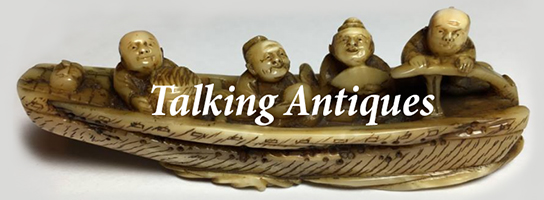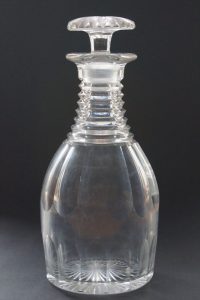Love Decanters
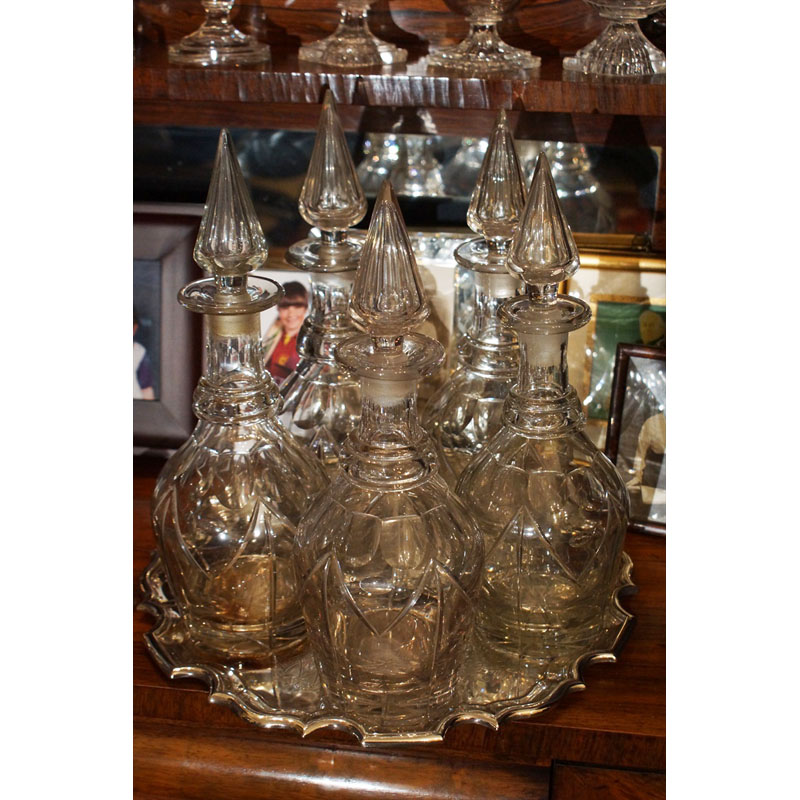
BUYING DECANTERS
Firstly, I am collector, so I collect and I am looking for bargains, and that is the view I am giving. I have on occasions sold off bits of my collection, but I in no way consider myself a dealer. My glass collecting started almost 25 years ago with decanters, got a bit out of control and now just focuses on decanters and associated tableware. The key driver for my focus on decanters is the physical constraints of what I can store and display.
In the time I have been collecting, as with a lot of traditional antiques the prices for traditional cut glass decanters of any kind have dropped dramatically. Things that were slightly out of my league when I started collecting have become almost every day purchases. Now is the time to buy if you are interested.
WHAT TO BUY?
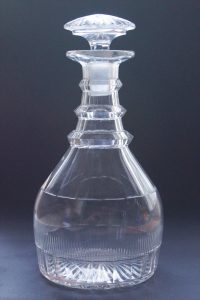 If you are looking for a more traditional decanter a good place to start is not by buying, but by looking. A good thing to look for, if you are into old school, are the decanters with three neck rings. Decanters with three neck rings were made between 1780-1845. A lot of what you see may also be copies as these were very popular in the period 1900-1940. A lot of dealers can’t tell the difference and there is a good chance you won’t be able to either. Quite often there is no price difference either, and the reason for this is because frequently the later copies are better quality and they often through the book at them when it comes to glass cutting techniques.
If you are looking for a more traditional decanter a good place to start is not by buying, but by looking. A good thing to look for, if you are into old school, are the decanters with three neck rings. Decanters with three neck rings were made between 1780-1845. A lot of what you see may also be copies as these were very popular in the period 1900-1940. A lot of dealers can’t tell the difference and there is a good chance you won’t be able to either. Quite often there is no price difference either, and the reason for this is because frequently the later copies are better quality and they often through the book at them when it comes to glass cutting techniques.
The decanter below is a Prussian shaped decanter with 3 bladed neck rings that was made circa.1830s. I bought this from an antiques centre a few months ago for the magnificent price of £22. This shows that if you want to be a bit flash and put a nice piece of real antique glass on your table, it is entirely possible. If you think about it, most of the copies are roughly 100 years old, so you really can’t go wrong.
If traditional cut glass is not what you are after and you would like something a bit more minimalist, I would recommend looking at 1930s glass. A good place to start would be with Whitefriars decanters. I can hear you thinking Whitefriars, that’s expensive. It’s expensive if you want to buy a brightly coloured knobbly vase designed by Geoffrey Baxter, but if you want to buy a 1930s decanter designed by Barnaby Powell, they will frequently be seen floating around on eBay for less than £20. Now that I am telling you this, they will be probably no longer be there. Beware though as I often see other manufacturers decanters being put forward as Whitefriars. Most frequently Thomas Webb, but they are good too.
Below are two Whitefriars M74 decanters from about 1940, in “Sea Green” and “Golden Amber”.
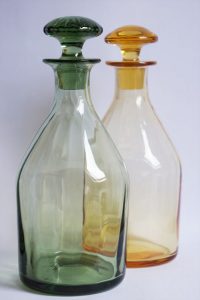
If you haven’t worked it out already, decanters are a deeply unfashionable thing to collect. Conversely they are not a thing to go into business with as you will starve. I buy some amazing bargains, but it has taken me twenty plus years of collecting to know when I am looking at something special, and even then I still couldn’t make a good living from them.
HAVING MADE THE DECISION TO BUY
Now that you have decided to buy your own decanter keep reading and I will try and explain some of the most common pitfalls that might befall you on this quest for elegant living.
THE WRONG STOPPER
How do you know if the stopper is not the original one that was made with the decanter? It is extremely common for antique decanters to have the wrong stopper in them. One simple way of checking is to see if it fits well. Decanter stoppers are intended to make an air tight fit and if the stopper is not an air tight fit, in all probability it is not original. Some decanters that are 200 years plus old are not air tight and should be bought for their history, not for practical use.
The other thing to look for is; does it look right? Does the style of the stopper match the decanter and does the colour of the glass match. Decanters and stopper that were made together should have stylistics clues to show they designed as a single item. Not all decanters and stoppers go together as obviously as the one illustrated below, so you do need to study the form.
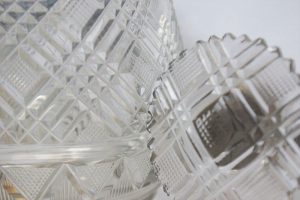
Antique glass is not as colourless and brilliant as modern glass, and it is often possible to see that 2 pieces of glass not made together do not have the same tone.
One other thing to look out for is scratched numbers. As each stopper is individually fitted to a decanter, many manufacturers scratched numbers into the stopper and decanter to make sure they didn’t get muddled up. If you find such a number on a stopper there should be a corresponding number on the decanter.
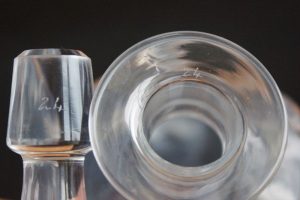
Some decanter stoppers have polished pegs and some have rough pegs, the state of the peg should match the condition of the part of the decanter that receives it. A mismatch in this shows it is a marriage. Here are a couple of illustrations of what I mean.
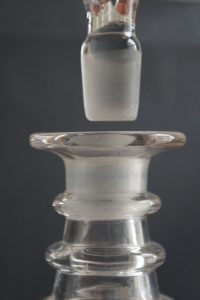
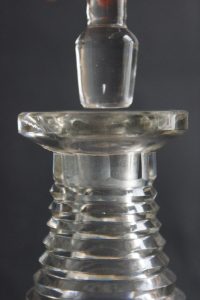
Finally, looking at pictures of the kind of decanter you would like and seeing what kind of stopper it should have is always helpful. The wrong stopper should make a huge difference to the value, so if you are buying decanter with the wrong stopper it should be cheap, cheap, cheap.
CLOUDY DECANTERS
There are two reasons a decanter might look cloudy. One is lime scale. If water has been left to evaporate out of a decanter, lime scale can build up in it. One simple way of removing this is with denture cleaning tables. Fill your decanter with water, pop in several tablets, and leave it over night. If this doesn’t work then it is probably bloom and this is a more serious problem. Bloom occurs when the stopper is left on a decanter whilst it is still damp inside. This dampness will constantly keep evaporating from the surface of the inside of the decanter and etches the inner surface. This can only be removed by having the inside re-polished, which is a professional job. It should cost less than £20. If you have bought your decanter to use then it shouldn’t matter as the drink will disguise the bloom. Bloom should affect the value of the decanter, so haggle over cloudy decanters.
Be aware that unscrupulous or unknowing dealers may leave the inside of a decanter wet. This will often disguise bloom, so if a decanter is wet inside give it careful scrutiny and question the dealer about condition. To illustrate this below are two pictures of the same decanter, one is dry on the inside and you can see it has really bad bloom. The other is after I have filled it water and tipped the water out. You can the massive difference.
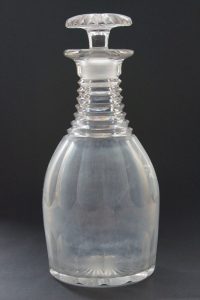
MANUFACTURERS
Knowing who made a decanter affects its value. In the between the wars period some British manufacturers started etching their names on the bottom of decanters. It is worth holding the bottom of your decanter up to the light to see if it has a name etched onto it. The names are small so look very carefully. Some very early Irish glass manufacturers pressed the name of company into the base of the decanter, but these are extremely rare. A rule of thumb is, knowing who made something instantly adds value. This is why it is worth working what you like and looking for it as an unrecognised bargain
DAMAGE
Damage effects value enormously. If you don’t mind the odd chip you can save fortune and sometimes if you are going for the older end of the market a small amount of damage is acceptable. The most common place to see damage on antique decanters is to see chips on the base of the stopper or the edge of the lip. If you imagine a drunken hand trying to get a glass peg into in a glass hole several thousand times there are bound to be a few collisions along the way. Chips to the bottom of the peg are more acceptable than to the lip of the decanter. Wear to the bottom of a decanter is normal, and if you are buying an antique and there is no wear on the base, be worried. Chips on the body are common on older cut glass and it really depends on how visible they are. Cracks of any kind are generally unacceptable and as a rule you should walk away from a decanter with a crack of any kind. I have knowingly only bought one decanter with a crack, and it was 99p plus postage, and is approximately 250 years old.
I will also mention claret jugs. A high percentage of antique glass claret jugs have a crack through the handle and this should greatly affect its value. Before you buy a glass claret jug, check the handle very carefully. If it is cracked, it should be very cheap, if you still want it.
If you are looking for antique glassware to use for everyday purposes I would extol the virtue of accepting something with a little damage. I can tell you from bitter experience it’s not a good feeling to break a piece of glass that has remained perfect for 150 years.
REPAIRS
One of the repairs I mentioned earlier is to have the inside of a decanter re-polished. This should do no harm and only enhance the value of a decanter.
Getting a replacement stopper fitted can have mixed results. It will make a stopper fit tightly, but the big question will be; does it look right? If it won’t look right after the deed is done, don’t embark on it. Even when a stopper is a good match, where a stopper has a rough fit (i.e. the stopper doesn’t have a polished peg) it is possible to tell if a replacement stopper is in place as the peg and hole won’t have any wear to them. Purist collectors won’t like this.
Where decanters have chips it is possible to have them polished out. How successful this is depends on how deep the chip was, how well the polishing is blended into the decanter, and how much it alters the shape of the decanter. For minor chips to the lip of a decanter it is worth doing if you have someone reputable to do it.
Cracks are impossible to hide and have a tendency to get bigger. You can try putting some super glue on a cracked decanter to stabilise it on a cherished piece. Historically cracks have been stabilised with rivets. This is done by drilling a hole on either side of the crack and pushing the ends of a hot staple into the two holes. As the staple cools and contracts it pulls the two sides of the crack tight, preventing it from flexing and getting bigger. This steampunk method of repair is not aesthetically pleasing as it looks like metal stitches have been put on the glass. Steampunk is cool, and many people don’t mind seeing this type of repair, as it shows a certain amount of history and it’s a job that takes skill to do. Personally, I like them.
FAKES
If you are after Georgian decanters you need to be aware that many copies were made in the first half of the 20th century as they were very popular. One way of spotting a copy is that they are often too good; the glass is too clear, the cutting too precise, there are too many rare Georgian features in one decanter. Often the decanter peg is polished and neat and fits too beautifully in the bottle. These decanters were not made to deceive they were made to cater for a taste of the time. As these decanters now have a bit of wear on them many dealers don’t know they are selling copies. If you are just going for a look these are excellent practical quality decanters and are worth a punt.
There are some notorious fakes out there, but the most expensive one you are likely to hit are for Irish Cork Glass Co. decanters. These were particularly faked in the 1930s when Irish glass started to become collectable and have a premium over new glass. Before buying such a decanter, make sure you get a cast iron receipt for it stating what period it is from.
I am sure other types of fakes exist, so just be weary of the upper end of the market when purchasing for investment. The one thing to your favour when purchasing expensive Victorian decanters is that cost is mainly based on quality. This quality is based upon skills and effort. Many of these skills no longer exist, and the cost of reproducing these types of decanters far out weights any perceived benefit.
PAIRS AND SETS
When buying decanters it is always better to have a pair, as with most antiques, a pair is worth three times as much as a single. With decanters you can also have matching glasses. Remember the number of glasses should normally be an even number and ideally six. The more decanters and matching glasses you have the better in terms of commercial interest.
If you purchase glass of a known maker and pattern it is possible to build a set. With eBay all is possible if you are patient. You can fill in missing pieces from firms that specialise in maintaining a stock old glass of common patterns, but you will have to pay top dollar for it from them and it’s kind of cheating and missing the fun of finding pieces and trying to get the best price.
Taking your time to build up a number of matching decanters pays off in the looks department and that is why the more the merrier.
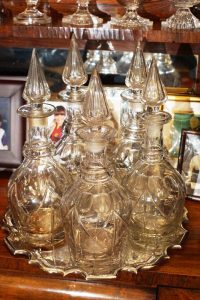

If you don’t have the patience to build up a set, try and stay in period to create a “look”.
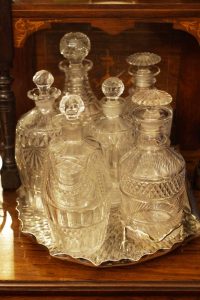
MODERN DECANTERS
When I say modern, I mean post WWII. They key thing to watch for when buying modern is damage, unless you are buying something you know to be rare and artistic, avoid buying if there is any damage. The only circumstance you might consider buying something with any damage is if it is very cheap and you plan to use it regularly. Also if you are buying something modern, try and buy something that is modern looking, i.e. looks like it came from the era you are buying from and not a new pastiche of a previous era.
AESTHETICS
Having decanters is supposed to be a part of elegant living and announces your arrival as a person of substance, etc, etc. So it is important that you know what look you are going for, are you going for elegant living in the Victorian, Edwardian eras, or are you into Art Deco, or cool 70s. It is all a matter of taste. Look up what you think you are going for, as even within a single time period there can be lots of genres and there are ways of achieving a look without splashing out on the real thing. Being a little ahead of the people that are selling things can save buyers a good deal of money.
Don’t expect me to know what is ahead of the game, I collect decanters which are really unfashionable. I am either totally ahead of the game or off my rocker.
WRONG ATTRIBUTION
Many dealers have no clue what they are doing with decanters, consequently believing the attribution of a dealer is a bit of a risk. I have purchased many decanters, because I realised what they were or I just thought they were good quality, got them home, turned them over and there is the makers mark as clear as day. The dealers didn’t even know to look there. The general lack of knowledge of decanters cuts both ways, you can find a bargain or be sold a pup.
CONCLUSION
Figure out what kind of thing you like before seeking to buy. Check the quality of what you buy, i.e. does it seem well made. If you like it and don’t think you are spending a lot of money you can’t go far wrong. If you do want to spend some money, make sure you have studied what’s out there before hand. EBay is a good place to start, as there is always a lot on sale so you can see the price ranges. Also make sure you see some decanters in the flesh too. If buying on eBay, think carefully about the size of what you are buying as one pint decanters are very common in the world of antiques.
HAPPY HUNTING!!
Kevin Barron
About Kevin:
I am an all round geek having worked in IT for 35 years, but I have always been interested in history, antiques and how the world works. I have collected antique glass. and particularly decanters, for about 25 years, and being a geek I am not just here for shiny things, I want to know the whole show, the art movements, the mechanics, the history, etc, etc.. I like to put a context around things and I like to share that knowledge.
